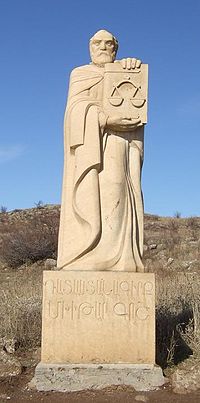Mkhitar Gosh (Armenian: Մխիթար Գոշ, romanized: Mkhit’ar Gosh 1130–1213) was an Armenian scholar,[2][3][4] writer, public figure, thinker, and priest. He was one of the representatives of the Armenian Renaissance.[5]

Biography
editHe was born in the city of Gandzak.[6] He got his early education from public institutions. When he reached his adolescence he decided to dedicate his life to the church. To learn theology more thoroughly, Gosh traveled to Cilicia, to the Black Mountains (Sev lerner), and studied orthodox theology under the local priests. Upon his return, he, along with the princes' Zakare and Ivane Zakarian financial help, built the church of Getik.
He wrote a code of laws including civil and canon law that was used in both Greater Armenia and Cilicia. It was also used in Poland, by order of king Sigismund the Old, as the law under which the Armenians of Lviv and Kamianets-Podilskyi lived from 1519 until the region fell under Austrian rule in 1772. He also wrote several popular fables. He founded the monastery of Nor Getik, where he was later buried. Ever since his death it has become better known as Goshavank. The works of Mkhitar Gosh were later adapted into a law codex in Middle Armenian, which was prepared by Sempad the Constable, a 13th-century Cilician Armenian noble, military commander, and judge.[7]
See also
editNotes
edit- ^ Robert W. Thomson. The Lawcode (Datastanagirk') of Mxit'ar Goš. — Rodopi, 2000. — p. 20: "In any event, his motivation stemmed from the fact that the Armenians of his time did not have a written legal code, and therefore those who wished to settle any legal question had to have recourse to outsiders."
- ^ Oxford Dictionary of Byzantium / Editor in chief Alexander P. Kazhdan. — Oxford University Press, 1991. — vol. 1. — p. 181.
- ^ Robert W. Thomson. The Lawcode (Datastanagirk') of Mxit'ar Goš. — Rodopi, 2000
- ^ Antony Eastmond. Tamta's World. — Cambridge University Press, 2017. — P. 126 "At the same time Mkhitar Gosh (d. 1213), the great Armenian jurist, poet, and theologian, worked for the Mkhargrdzelis from the monasteries of Getik and then Goshavank, both of which were sited well away from any large settlements."
- ^ Encyclopedia Americana. — Americana Corporation, 1965. — vol. 2. — p. 270: "The Armenian Renaissance reached its height in this period, with the works of the Vardapet Hovhannes (John) Sarkawag (d. 1129), ... Hetum, author of Narratives of the Tatars and Chronological Tables; Hovhan Erzenkatsi (John of Erzincan), moralist, theologian, poet, and grammarian; Nerses Lambro- natsi (Nerses of Lambron, 1153-1198), theologian, moralist, and orator; Mekhitar Gosh (d. 1213), who compiled the Armenian Code"
- ^ Grave of Mkhitar Gosh
- ^ "Smbat Sparapet." Dictionary of the Middle Ages
External links
edit- Robert W. Thomson. The Lawcode (Datastanagirk') of Mxit'ar Goš. — Rodopi, 2000
- English translations of Gosh's Fables and his Colophon are available at: http://rbedrosian.com/hsrces.html
- English translations of the Fables and Colophon - mirror if main site unavailable
- Grave of Mkhitar Gosh